The plane ride was remarkably pleasant. After years of traveling on budget airlines, finally I had a bit of luxury—spacious seats, decent food, an entertainment system, and even free cologne in the bathroom. I was even more impressed when I stepped off the plane. We were in the new Istanbul Airport, which has been opened just the month before, in April of 2019. (This replaced the older Atatürk Airport, now used only for shipping and cargo.) The place was striking. Everything was sleek and shiny, with a futuristic design reminiscent of a spaceship. This was not what I expected when I chose to fly to an ancient city.
This was Holden’s second time in the city, and my first, so I was following his lead. We withdrew some Turkish Lira from an ATM (worth about ten Euro cents a piece), and then found the bus to Istanbul. Even this bus was pleasant (it had free wifi!). We were dropped off in front of a big hotel, and had a quick bite to eat in a nearby Kebab place.
Now, I need to say a word here about kebab—more specifically, döner kebab. It is a staple in Europe. Indeed, along with pizza, it is one of the only truly pan-European foods. You can find kebab shops in Italy, Spain, France, Portugal, Poland, Germany, or England—all with the same rotating spits of meat, the same shabby decor, the same disposable napkins and frozen french fries—and you are always guaranteed a cheap and filling meal of bread and meat, with a sprinkling of lettuce and, perhaps, the odd tomato thrown in. For two years I even lived above a kebab shop, and breathed in the meaty aromas which wafted up from below, filling me with strange cravings at odd hours.
Unfortunately for me, the kebab in Spain is notably worse than the kebab elsewhere. I blame it on the Spanish preference for bland foods. To adapt to the local tastes, kebab owners here tone down the spices, reducing the flavor to that of a standard hamburger. Even so, during my nights out, after some drinks with friends—or before, or during—I came greatly to appreciate the humble döner kebab, so cheap, fast, and ubiquitous. This may seem to be quite a lot to dedicate to a bit of ground meat on a bun; but I want to explain why I was so excited to try a kebab in Turkey, its birthplace. I was finally in the Mecca.
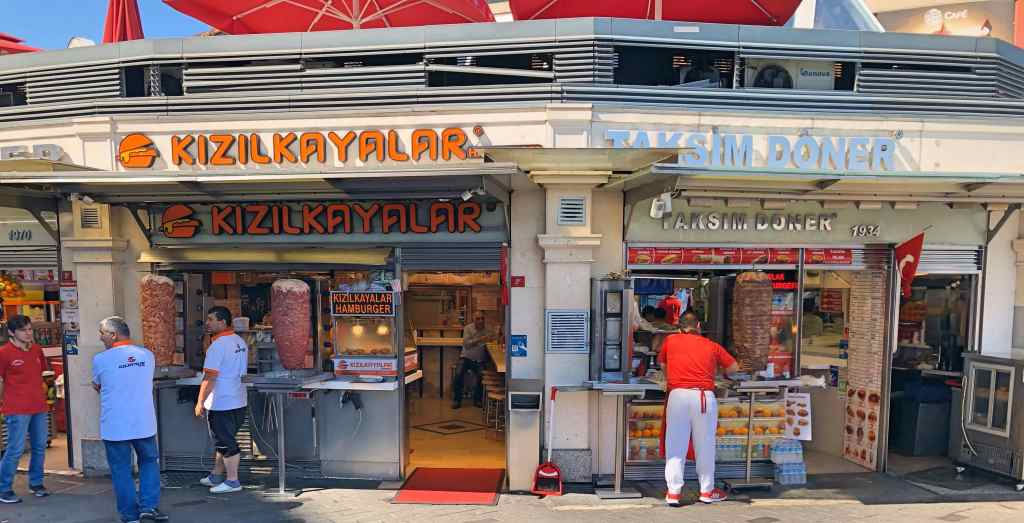
The kebab arrived, and I devoured it with passion. Absolutely scrumptious—far better than the Spanish version. But it was late now—approaching midnight—so we could not stay to savor the meal. We found our Airbnb and got ourselves ready for bed. The next day our trip would truly begin.
If asked what the largest city in Europe is, I suspect most people would say London, Paris, or perhaps Moscow. But with 15 million souls, Istanbul easily takes the cake. Admittedly, the city is not wholly European: it straddles the continental divide between Europe and Asia. Roughly half of the city sits on either side of the Bosphorus (the strait that connects the Mediterranean with the Black Sea), which has always put Istanbul in an ideal place to dominate trade, as this is a natural bottleneck. We should not be surprised, then, that the city’s roots stretch far back to antiquity.
Istanbul is a city with three names. In addition to its current appellation, it has been called Byzantium and Constantinople. The city began, like many cities around the Mediterranean, as a kind of Greek colony and trading post. The Romans, as was their wont, eventually conquered the city; and when the great Roman Empire grew unwieldy, and split into West and East, Byzantium became the capital of the new state (thus the name Byzantine Empire). Shortly thereafter, however, the city changed its name to honor the great Constantine, who is now remembered mostly as the emperor who converted to Christianity; but he did an awful lot of things besides that—most notably, govern well.
For centuries thereafter, Constantinople was one of the great cities of the world. As the Western Roman Empire collapsed, and Europe was swallowed up by the Dark Ages, the Byzantine Empire preserved much of the pomp, prestige, and power of the erstwhile Romans. The city remained a major center of trade—particularly on the Silk Route—as well as an important barrier between the new religion of Islam and Christian Europe. After a very long and very slow decline (famously catalogued by Edward Gibbon) the city finally fell on April 6, 1453, to the Ottomon Turks, who used cannons to break through the previously impregnable city walls. As Gibbon narrates it:
It was thus, after a siege of fifty-three days, that Constantinople, which had defied the power of Chosroes, the Chagan, and the caliphs, was irretrievably subdued by the arms of Mahomet the Second. … The senators were linked with their slaves; the prelates with the porters of the church; and young men of the plebeian class with noble maids, whose faces had been invisible to the sun and nearest kindred.
But of course that was not the end of its story. The city became the capital of the powerful Ottomon Empire for another five centuries—until finally, after independence was won from the Allied Powers, the capital was moved to Ankara, and Constantinople renamed Istanbul. Even so, few would doubt that Istanbul remains the most important city in Turkey. Indeed, though somewhat fallen from the glory days of Constantine, Istanbul is still one of the most important cities in the world.
It is also, as it happens, one of the most enchanting.
I only had one demand of Holden: that we see the Hagia Sophia. So that is where we headed to first.
It was a stunningly sunny day, the sky a piercing blue. After a bit of fumbling, we managed to get tickets for the tram from the machines, and off we went through the city. The tram took us over the Galata Bridge, which spans the Golden Horn, an inlet of the Bosphorus. The spires of minarets and the domes of mosques loomed in the skyline overhead. The streets teemed with people. The city had none of that sterile polish that some popular tourist destinations have. It was immediately clear that Istanbul was a real place.
Locating the Hagia Sophia was no challenge. But buying tickets presented us with a dilemma. We had the option either to buy a single entry to the museum, or to buy a combination pass that included many other monuments. I normally shy away from such passes, since you lose money unless you visit most or all of the sites; thus buying it commits you to a certain itinerary. So I elected for the single entry. But Holden reached the opposite conclusion, which led to a competition between us: Who would save money in the end? I will not bother with suspense: Holden won. I humbly recommend the combination pass.
In any case, it is too vulgar to dwell on such things in the presence of the Hagia Sophia, one of the great architectural wonders of the world. Completed in 537, under the rule of Justinian, its name literally means “Holy Wisdom.” Two churches had previously occupied this spot; both burned down. Justinian was determined that his own effort not meet with the same fate, and so ordered the new building to be made of brick and stone.
Isidore of Miletus and Anthemius of Tralles were chosen to design the new building, even though they were both mathematicians rather than architects. It was a brilliant choice, as only a mathematician could have designed the series of pendentives and semi-domes that culminate in the crowning central dome, mutually supporting one another over a vast internal space. With the help of some 10,000 workers, they created both the largest dome and the largest cathedral in the world—not to be surpassed for almost a thousand years. (Its dome was eventually surpassed by the Duomo in Florence, and its size by the Seville Cathedral.) Admittedly, an earthquake caused the roof to partially collapse just a few months after it was completed, which required extensive reconstruction.
The Hagia Sophia is a building marked by time. Much has changed since it was first built. For one, the marble covering its façade has almost entirely fallen away, leaving the structural brick exposed. This gives the current building a slightly shabby aspect from the outside; but in its day it would have glimmered brightly in the Mediterranean sun. Many other changes are due to the building’s religious history. After it was converted from a church into a mosque, four massive minarets were constructed on each corner of the building, whose spires even extend beyond the top of the dome.
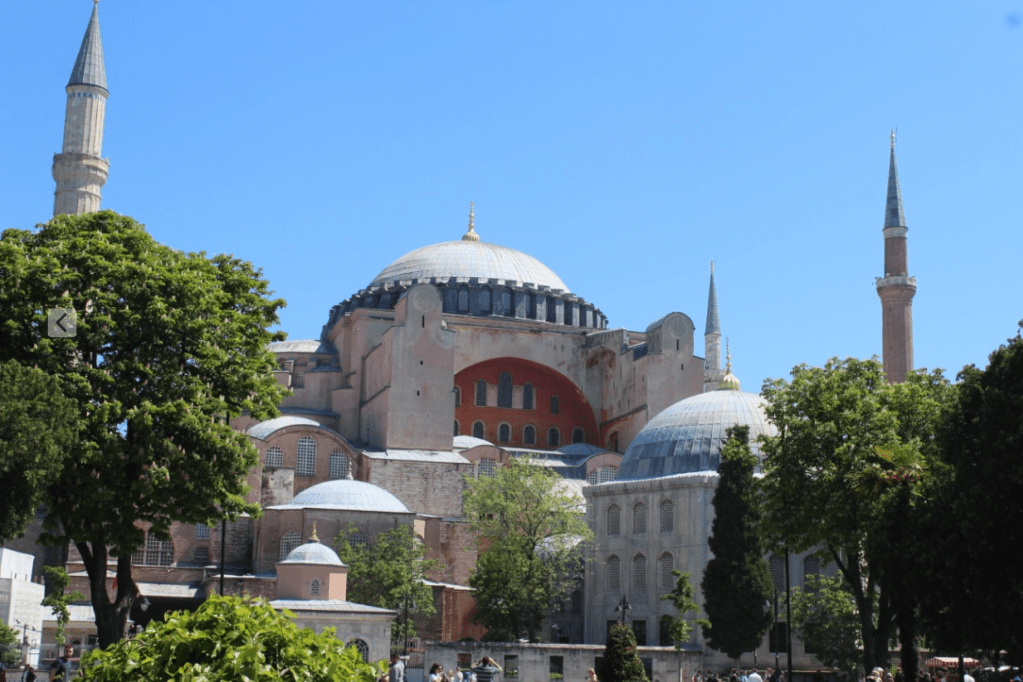
The inside presents the same contrast of religions. The most obvious sign of Islam are the eight large medallions bearing ornate calligraphy, boldly displaying names of Muhammad, Allah, the caliphs, and Muhammad’s grandsons. There is also a mihrab where the Christian altar used to stand, though it seems strangely misaligned, as it had to point to Mecca in a building which points to Jerusalem. The Christian elements are no less obvious. The walls are covered with elaborate, golden mosaics, depicting Jesus, Mary, Emperors, Empresses, and Saints. These had all been covered with plaster during the centuries when the Hagia Sophia was a mosque, as representational imagery is considered sacriligeous in Islam. They were carefully uncovered during the mosque’s conversion into a museum in the 1930s. The strangest of these might be the six-winged seraphim adorning the pendentives—a bundle of feathery wings with no face, appendages, or bodies.

A few curiosities stand out for note. There is the Wishing Column, a column with a hole in it that apparently was replaced with a piece of bronze. Curiously, the bronze now feels oddly wet, for which reason it is also called the sweating or the crying column. In any case, touching this perspiring indentation is supposed to bring you good luck. Also curious are the two enormous urns, meant for the ritual purification of Muslim worship. The urns themselves were actually carved in Ancient Greece out of two even more enormous blocks of granite—an incredible feat. Most amusing, for me, were the graffiti carved into the upper-story railings. While you may think that these have some religious significance, they were actually carved by soldiers in the Emperor’s Varangian Guard—an elite bodyguard unit, with members recruited from the brutal northern lands. In other words, there are runic inscriptions carved by Vikings in a building in Turkey.

As for the majestic beauty of the place, I will leave that to Edward Gibbon:
A magnificent temple is a laudable monument of national taste and religion; and the enthusiast who entered the dome of St. Sophia might be tempted to suppose that it was the residence, or even the workmanship, of the Deity.
But he also adds:
Yet how dull is the artifice, how insignificant is the labour, if it be compared with the formation of the vilest insect that crawls upon the surface of the temple!
It is true that cathedral architecture does lag far behind insect evolution in complexity and efficiency of design. But I still prefer the Hagia Sophia.
I cannot move on without noting the recent decision to turn the Hagia Sophia back into a working mosque, rather than a museum. Thankfully, this time around, the Christian artworks will not be plastered over. Even so, many people criticized the decision, as the Hagia Sophia has long been considered to be a symbol of co-existence between the two religions. But to be fair, Christians are still worshipping inside the Great Mosque of Cordoba, which was turned into a church when the city fell to Christian conquerors, about 200 years before Constantinople was taken by Mehmed II. So perhaps we should make an exchange.
Standing right outside the Hagia Sophia is another ruin of the ancient city, though you may not recognize it. The current Sultan Ahmet Square occupies what used to be the Hippodrome,* Constantinople’s version of the Circus Maximus. That is, it was an enormous stadium—big enough for 100,000 spectators—used for chariot races and other amusements. None of the stadium survives; but some of the monuments placed in the center of the race track do remain. One of these is the Serpent Column. This was actually the base of a sacrificial tripod, made in the 5th century BCE to commemorate the victory of the Greeks against the Persians; and originally three snakes’ heads extended from the twisted bodies of the column. Unfortunately, those delicate heads rusted off a few hundred years ago, leaving only the slithering column at the base.
(*Hippodrome is Greek for “horse course.” The word “hippopotamus,” by the way, comes from the Greek for “water horse.” Hippocampus, used for both the animal and the part of the brain, means “sea horse.”)
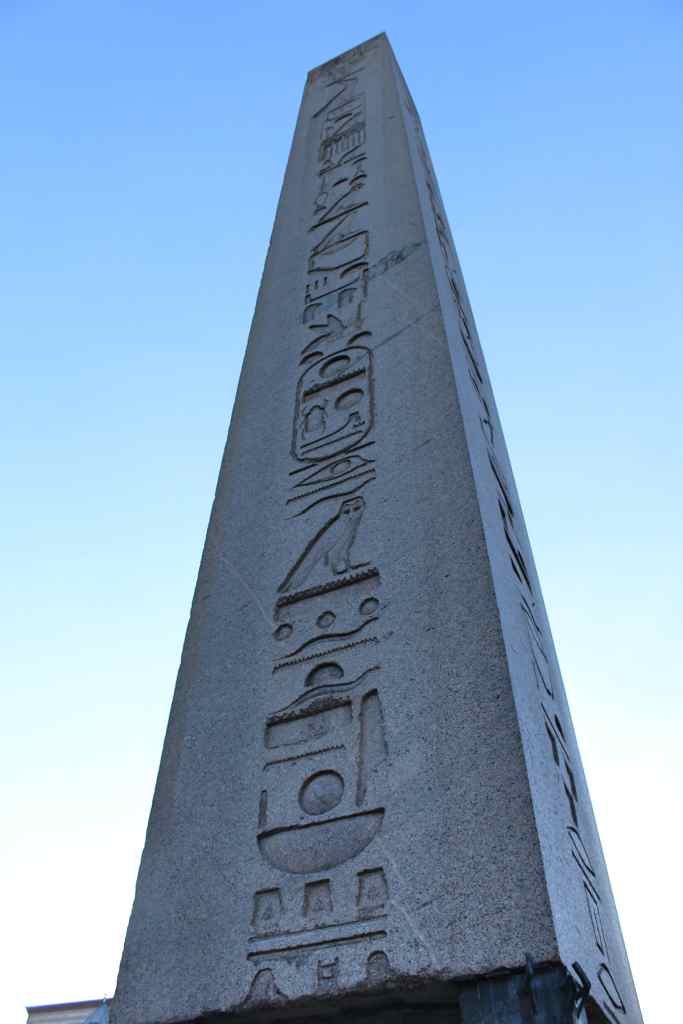
That Greek column was transported here by the Romans as a celebration of their power. The same was done with the Obelisk of Thutmose III. This is an enormous stone tower, built around 1490 BCE during Egypt’s 18th Dynasty (Thus, this column was more ancient to the Byzantines than they are to us!) It was transported here during the reign of the emperor Theodosius, for which reason it is sometimes (though unfairly) referred to as the Obelisk of Theodosius.
In his excellent course on Ancient Egypt, Bob Brier remarks that obelisks were enormous engineering accomplishments, arguably more impressive than the pyramids. This is because they were made from a single piece of stone. Moving them from the quarry, and getting them into position, was thus a terrific challenge—not only because of its massive weight, but also because it could easily crack if not properly supported during transport. As a case in point, this obelisk was damaged when the Byzantines moved it here, effectively losing over a third of its original height. As another case in point, the so-called Walled Obelisk, built by the Byzantines as a kind of matching twin to the Egyptian original, is made from cut stone—that is, assembled out of little pieces, rather than carved from a single rock. It certainly looks shabby when compared to the original.
I should here mention the infamous Nika riots. During the reign of Justinian, in the 6th century, chariot racing was intertwined with political affiliation. The populous divided itself into factions—blues, greens, reds, and whites—which were as much like street gangs as political parties. After chariot races, hooligans frequently clashed, sometimes with fatal results. But in the year 532, tensions were coming to a head. Justinian had become so unpopular that, at one chariot race, partisan loyalties were thrown aside, and the entire populace turned against him, chanting “Nika!” (“Victory!”). The rioters started attacking the palace and destroying the city. Justinian (prompted by his wife, Theodosius) stayed to command his forces against the mob. By the end of the riots, tens of thousands of people had been killed, and half of the city burned down. Indeed, this is what gave Justinian the opportunity to build the Hagia Sophia.
Looming over this ancient racing ground, within sight of the Hagia Sophia, is another iconic monument. Yet this one is not ancient. I am talking about the famous Blue Mosque, though it is properly called the Sultan Ahmed Mosque. Sultan Ahmed I ruled the mighty Ottomon Empire from 1603 to 1617, notably deciding not to kill all of his brothers when he ascended to the throne. (Sultans typically had many sons, from their polygamous ways; and it was customary for the new sultan to get rid of the competition when the time came to rule.) Though his life was eventful by any standard, he is mainly remembered now for the erection of his eponymous mosque. Indeed, he is buried in a türbe (tomb) right outside its walls—a surprisingly humble shrine for such royalty.
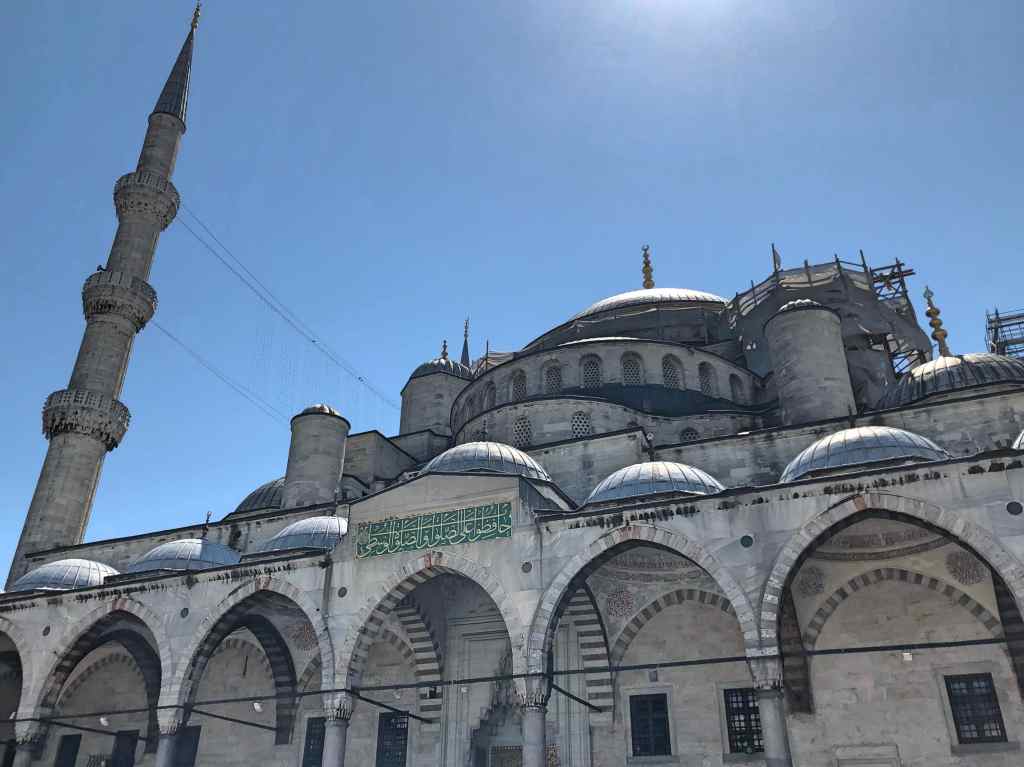
The Blue Mosque is still very much an active place of worship. This means that, five times a day, the muezzin sings in a husky, melismatic voice: “Allah is the most great. I testify that there is no God but Allah. I testify that Muhammad is the prophet of Allah. Come to prayer. Come to salvation. There is no God but Allah.” In the old days the muezzin would ascend to the top of the minaret and shout out this call at the top of his lungs; but nowadays they use loudspeakers rigged up to the minarets. In any case, it is a lovely and haunting sound—seeming to encompass the whole culture in a few lines of melody. But this does mean that the Blue Mosque (as with any mosque) is sometimes unavailable for visits.
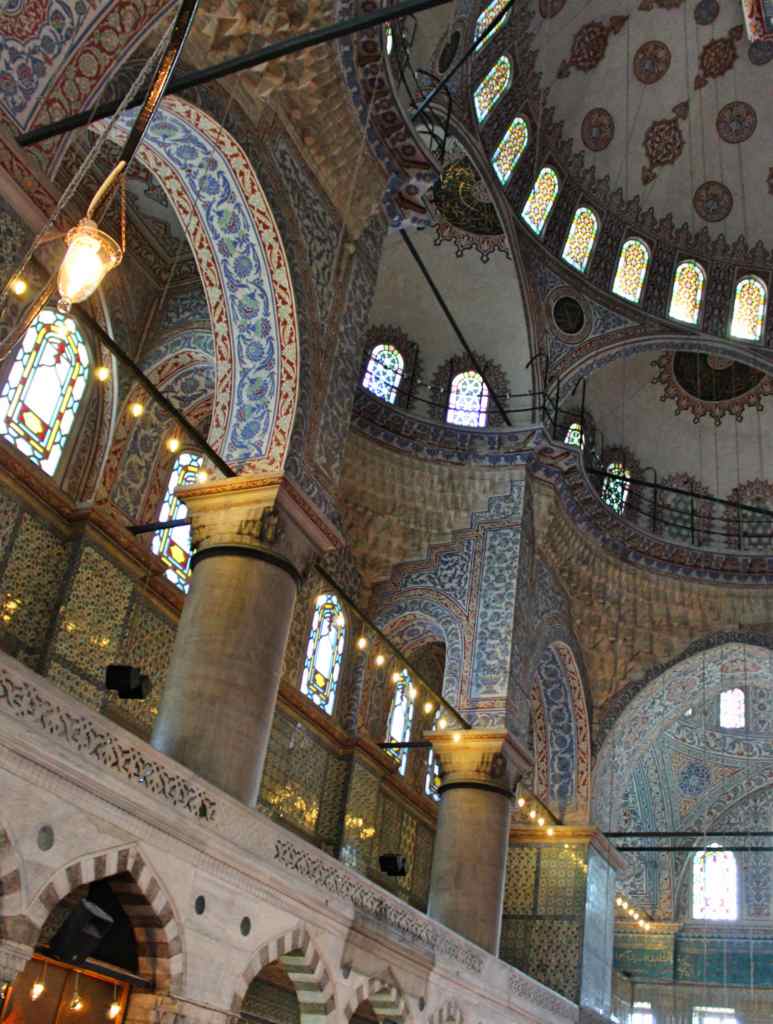
From the outside one can easily see the influence of Byzantine architecture on the Ottomon style. Much like the Hagia Sophia, the Blue Mosque is composed of a series of cupolas and semi-domes that culminate in the large central dome. Its appellation notwithstanding, the hue of its façade is, at best, only vaguely azure. Visiting the mosque means getting in a queue and shuffling through the impressive courtyard that sits in front of the entrance. Shoes must be removed for the visit (little plastic bags are provided to carry them), and women must cover their hair (scarves are provided if you do not have one). Some Westerners may bristle at the sexist double-standard, though to be fair I have seen women being told to cover up in Rome before visiting Basilicas. So perhaps we are not so different.
I had never been inside a mosque before, so I did not know what to expect. What first struck me was that the inside was a lot less “busy” than a European church. Whereas a cathedral is full of little altars and shrines, with saints and angels jumping out at you from every corner, the Blue Mosque was open and empty. The floor was covered with an enormous prayer rug (red, not blue), and the walls decorated with ceramics of highly elaborate floral designs. As mentioned above, Islamic art considers depictions of the human form—especially of religious figures—to be profane, a prohibition which prompted Muslim artists to develop abstract design to prodigious heights. Yet what I found most charming about my visit was that there were young men passing out copies of the Koran, in multiple languages. I requested and got an English version—with an appropriately blue binding—which now sits proudly on my bookshelf. I ought to read it soon.
Our next stop was the Topkapi Palace. This was the center of Ottomon power while the empire was at its height, built by the order of Mehmed the Conqueror, six years after he took Constantinople. Unlike monstrous European palaces—everything gathered under one enormous roof, Versailles being the prime example—Topkapi takes the form of a series of walled courtyards, each more intimate than the last. In other words, the palace is spread out rather than piled in a heap. The place is quite massive, so I will not even attempt a general description. But there are a few highlights. What most sticks out in my memory is the impressive collection of porcelain, how displayed in the palace’s kitchen. Here the Muslim genius for decorative art is displayed to full affect, as the ceramics were covered in lush patterns.
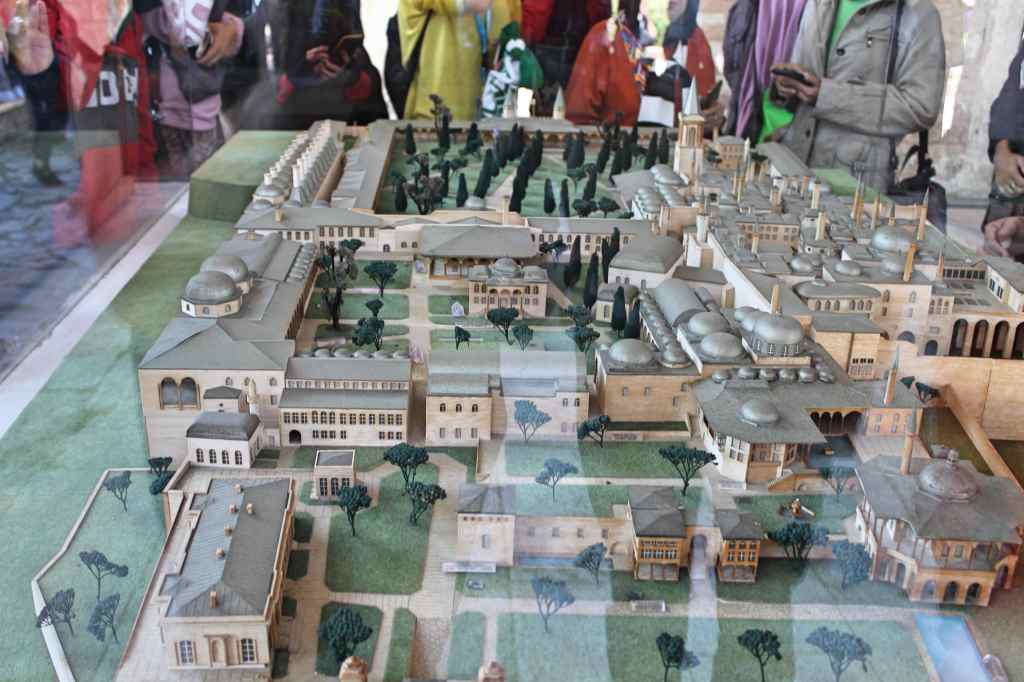
In the third courtyard, in the Sultan’s private chamber, there is also a display of Islamic holy relics. These include things like Muhammad’s footprint, his bow and sword, his robe and his banner, and a letter by his hand, in addition to relics of Moses and John the Baptist. In one room, a hafiz—someone who has memorized the entire Koran—keeps up a continuous recital of that sacred scripture (presumably they do it in shifts). Koran recitation, by the way, is a serious artform in the Muslim world; to Western ears it sounds like music. The most impressive architecture is to be found in the fourth courtyard, where a series of beautifully decorated kiosks, full of delightful ceramics. Here you can also enjoy a view of the Golden Horn and the Marmara Sea.
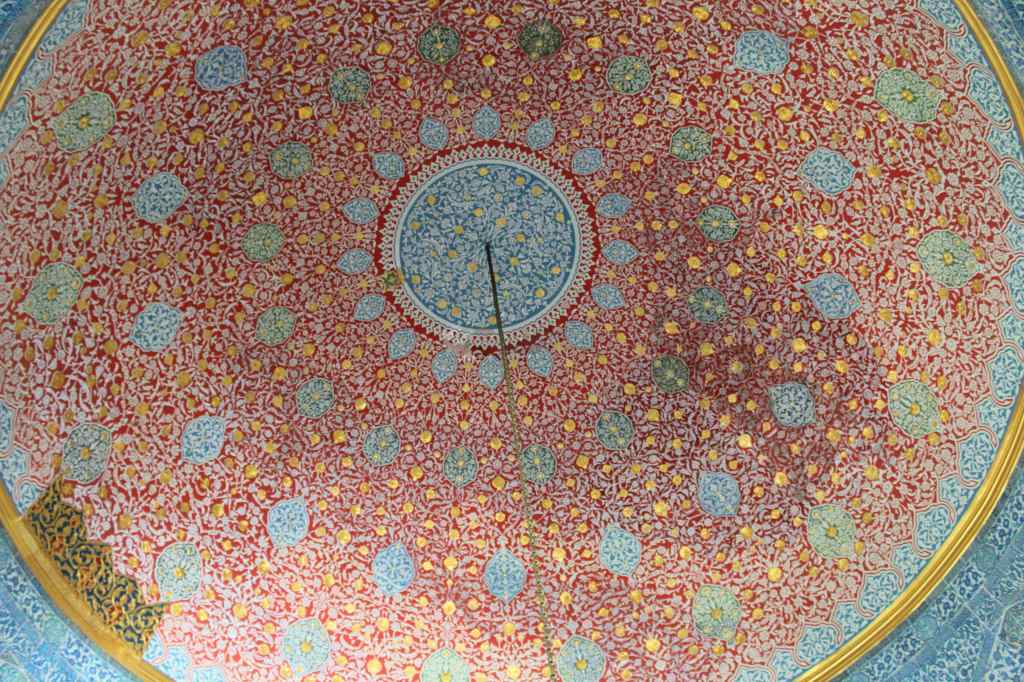
Unfortunately for me, however, I did not get to see one of the most interesting parts of the palace: the Harem. This was because it cost extra to go inside—that is, if you did not have the pass. Perhaps I would not have minded paying; but I was determined to show Holden that I would save money through my decision not to buy the bass. Holden, meanwhile, strolled right inside, leaving me to wait in the courtyard. In any case, it is worth noting that the harem was not exactly the den of pleasure imagined by European orientalists, where the Sultan luxuriated among limitless numbers of concubines. Indeed, his whole family lived there—including, most notably, his mother, who was involved in selecting women for the Sultan. Still, judging from the photos, it was probably a pretty nice place to be (at least for the Sultan).
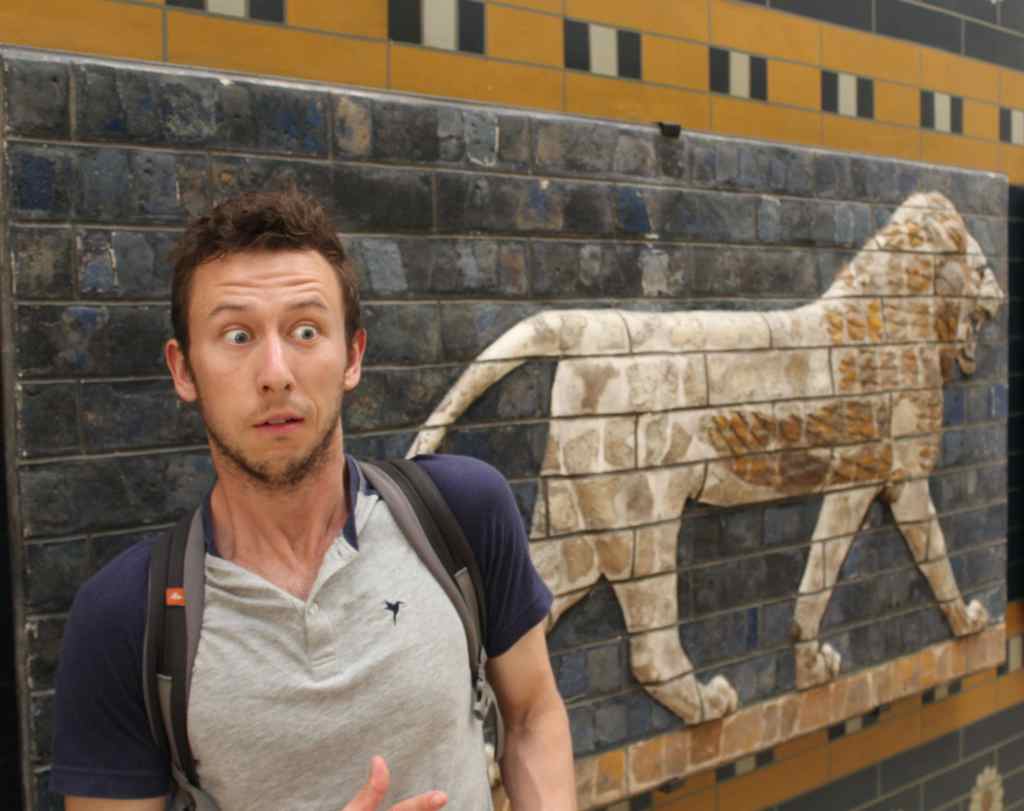
Right next to Topkapi is perhaps the finest museum in the city: the Istanbul Archaeology Museum. In fact, you do not even need to go inside to enjoy the museum’s collection, as the courtyard is littered with stone fragments—of sculptures, columns, and even sarcophagi—a kind of graveyard for monuments. Even though part of the museum’s collection was unavailable due to construction, I still came away quite impressed by the visit. There are, for example, some examples of Ancient Mesopotamian art, such as the wonderful Ishtar Gate, or clay tablets bearing cuneiform inscriptions; and the many busts, friezes, and mosaics—from Egypt, Greece, and Rome—should also be mentioned. But the highlight of the museum is its extensive collection of sarcophagi. The most famous of these is the Alexander Sarcophagus, reputed to belong to the great conqueror. Alexander is certainly depicted on the outside (in much the same manner as in the Alexander Mosaic, in Naples), but it is very doubtful that this was actually his resting place. Even so, it is a beautiful place to be dead in.

After enjoying the museum, we headed to the Basilica Cistern. This is so-named because, in this spot, a Basilica once stood, facing the Hagia Sophia. Now, only the underground rainwater receptacle remains. But it is impressive in itself. The visitor pays the fee (it isn’t included in the Istanbul pass, much to my delight and Holden’s chagrin!) and descends a tunnel into a kind of damp cave. There, you walk on a platform (the cistern is mostly drained, but some puddles remain on the floor), observing the strange subterranean environment. It is an enormous space, big enough to hold 21 million gallons of water. The roof is supported by 366 marble columns, most rather plain, but some quite elaborately decorated. One column is decorated with eyes, which seem to be weeping tears—apparently a tribute to the slaves who died constructing the cistern. Two other columns rest on enormous carved statues of Medusa (a case of recycling materials). In any case, it is clear that the Byzantines knew the value of water.
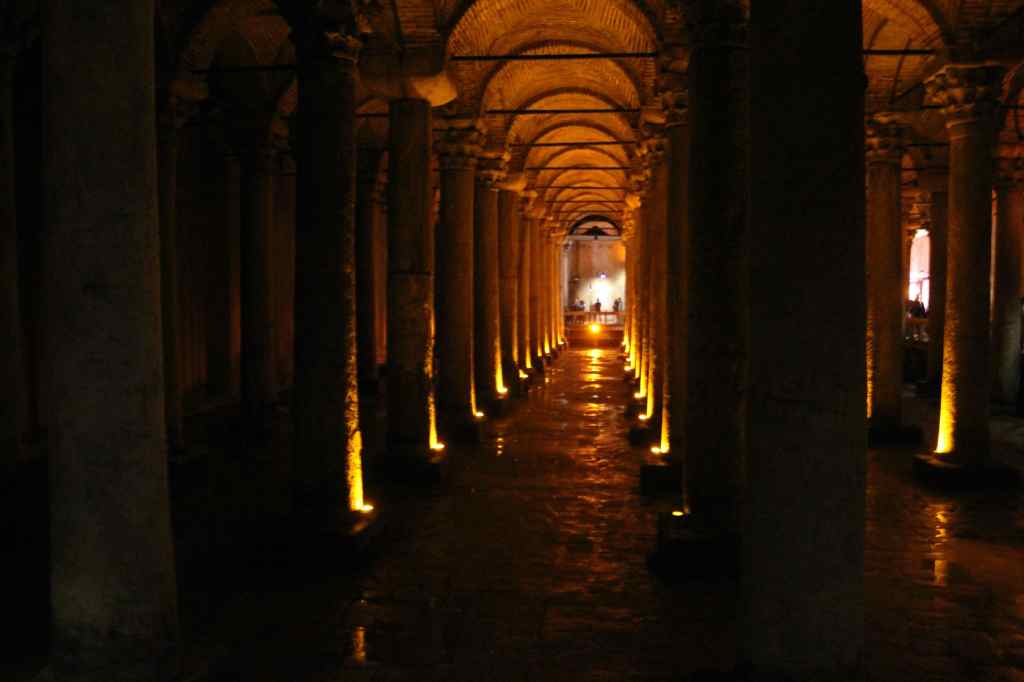
After saying so much about the major monuments of Istanbul, I ought to take some time to describe the city itself, as well as its people. This was my first time in a predominately Muslim country, so a lot was new for me. I found the innumerable mosques, with their minarets and domes, to be endlessly charming; and the call to prayer (adhan) never failed to send a little shiver down my spine. What is more, it was Ramadan when we visited, which meant that, every evening, right as the sun was setting, one could observe the people scrambling to eat. One policewoman carried a stack of pizza boxes to her fellows, as they got ready to devour them at the appropriate time; and vendors rapidly set up shop along the streets, with rice and chickpeas ready to be sold to hungry customers. Another consequence was that alcohol was not especially manifest. Granted, if you wanted to find a beer, it was not especially difficult; but it was not reliably sold at every corner store. And, of course, most women walked around with their hair covered (and some with their face veiled, too).
My impressions of the Turkish people were entirely positive. In every interaction we had, they were unfailingly attentive, polite, and helpful. The helpfulness was the most striking thing. Any time we asked someone for directions, they would really go out of their way to help us out. Holden, for example, was determined to get a haircut while we were there, but we did not know where to go. When Holden asked a bystander who was sitting on a bench, smoking, he got up and walked us several blocks to a barbershop. Then he even called inside to the barber, and led us in, purely out of courtesy! (The haircut, by the way, was quite special: The barber used only scissors, no electric razor, and layered the hair with diligent skill. He also gave Holden a shave with a straight edge razor, and even used a little torch to burn off the peach fuzz on Holden’s face and neck. It was quite a performance.)

Aside from its many monuments, the city of Istanbul itself is not exactly beautiful. Yes, the bridges and waterways provide for a nice view; and many neighborhoods are reasonably attractive. But great swaths of the city are run-down, with damaged buildings and shabby roads. Feral cats and dogs were a constant presence, so much so that I doubted whether any Turks had any actual pets. To get a good taste of modern Istanbul, you can head to Taksim Square, one of the major plazas of the city. It is ringed by hotels and restaurants, where tourists are inevitably gathered. In the center is the Republic Monument, which celebrates the founding of the Turkish Republic in 1923. Mustafa Kemal Atatürk—freedom fighter and first president of Turkey—occupies pride of place in this monument; indeed, he is on both sides of it.

But Holden would argue that Istanbul is not best seen from any square, street, or building. As he is fond of saying, “The best way to see a city is by boat.” It is his mantra, his life’s creed. In keeping with this sage principle, therefore, we decided to take a little Bosphorus cruise. The waterway is constantly full of little ferries, transporting busy Istanbullulars north and south, and from Europe to Asia and back again. You can buy a ticket for one of these ferries for an exceedingly reasonable price (though Holden and I struggled to find exactly where to buy the tickets, and which ferry line to use). So after Holden had his hair cut, we were off to the seas for the absolute best possible view of Istanbul.
It was a sparklingly clear day, with cloudless skies and shimmering waters. Seagulls floated motionless on the gales as we ascended the gangplank and found seats on the upper deck. It was not crowded. Soon the ship had pulled away from shore, and we were cruising northeast, hemmed in by two continents. We all around us were gargantuan cargo vessels, full of multi-colored shipping containers. (According to Rick Steves, many of these are Russian, as the Bosphorus is still a major artery between Russia and Europe.) In the distance, swimming among these leviathans, I spied the black backs of a pod of dolphins, coming up for air.

Holden was correct: the city was very attractive from this vantage point. I especially liked the many mosques and minarets that adorned the surrounding hills like crowns. Far off, we could spot the commanding form of the Çamlica Mosque, the biggest mosque in the city, which had opened just a few months before our visit. After fifteen minutes or so we came upon the Dolmahbahçe Mosque—a small and lovely mosque that sits on a platform over the water. Right up river is the Dolmahbahçe Palace, which replaced the Topkapi Palace as the center of Ottomon Power in 1856. Unlike its predecessor, Dolmahbahçe is transparently European in inspiration and design, imitating Versailles in its weighty grandeur.

Further on, we encounter the Rumelihisari. This is a large fortress, built by the orders of Mehmet II (the Conqueror), with the intention of choking off boat traffic on the Bosphorus. This effectively prevented any kind of aid from reaching Constantinople during its final siege. Finally we reached the Bosphorus Bridge. Opened in 1973, it was the first permanent bridge to span two continents. (In his attempt to conquer Greece, the Persian Emperor Darius had a bridge of pontoons built for his army to cross.) Leonardo da Vinci first proposed a suspension bridge here in the 16th century; it took the rest of us a little while to catch up with his vision.

Such was our little cruise, which lasted about two hours. (There are longer ones that take you all the way to the Black Sea, a day-long affair.) Holden may be right about his boat theory. But if you do have to see Istanbul from land, then perhaps the best place to go is the Galata Tower. This is a tall watchtower—measuring about 60 meters, or 200 feet—that was built in the 14th century. The Genoese had a colony in the city at that time, which they used as part of their extensive trading network; and they built the tower as a kind of lookout on the Bosphorus. The visit seemed a bit overpriced (and it wasn’t included in Holden’s pass!), but the panoramic view of the city is difficult to beat, even if you do happen to be on a boat.
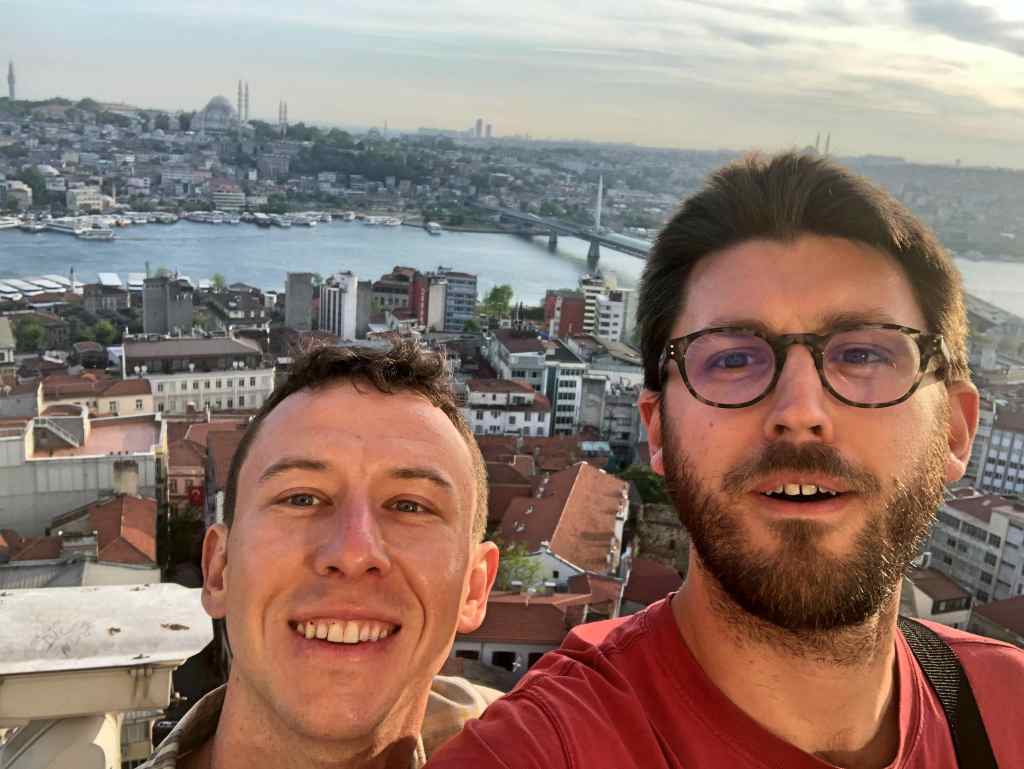
On any trip to Istanbul, it is pretty well obligatory to pay a visit to the Grand Bazaar—even if, like me, you are no great fan of shopping, and have no need for touristy souvenirs. Here you can see that the idea of a shopping mall has impressively hoary roots, as this enormous market was opened back in the 15th century. The bazaar is fairly inconspicuous from the outside; but once you go inside, you find yourself wandering in an enormous maze of covered passageways—61 streets in total. All around you are shops and stalls, selling textiles, spices, jewelry, makeup, and sweets like Turkish delight. None of this may appeal to you (I didn’t buy anything), but it is enjoyable simply as a spectacle.
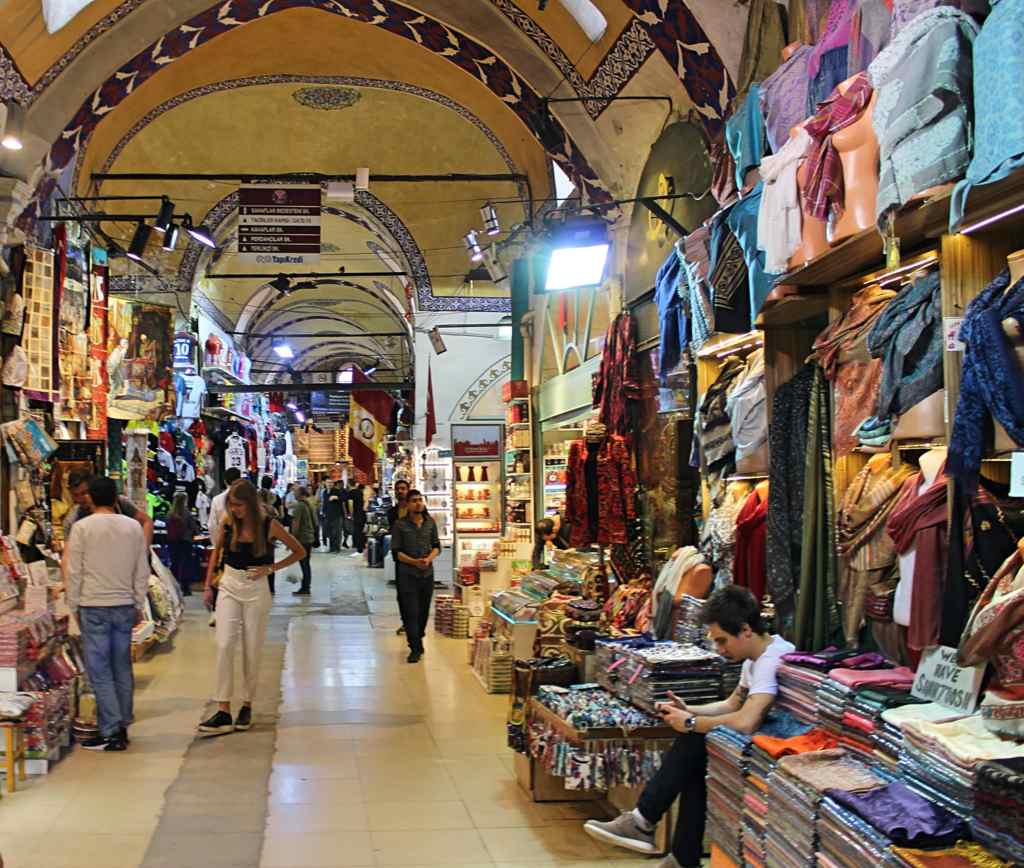
Standing quite close to the Bazaar is the oldest monument in the city: the Column of Constantine. In its current form, you may wonder why this lumpy bit of stone is famous. But when it was constructed, this column was enormous (perhaps the biggest triumphal column erected by the Romans) and glorious, featuring a shining bronze statue of Constantine on the top. A gust of wind eventually blew down the statue, as well as a few chunks at the top of the column, which was replaced with a cross. Then the crusaders blundered the bronze rings that held it together, and the conquering Muslims had the cross removed. Finally, the column was scorched in a fire, giving it a distinctive black tint. These days, a masonry base has replaced the original marble one, and iron braces hold the porphyry of the column in place, which makes it a rather ugly sight. But it is still worth seeing, as this column commemorates the renaming of Byzantium in Constantine’s honor, in the year 330.
Our next visit was a less ancient monument: the Süleymaniye Mosque. Until it was surpassed, in 2019, by the aforementioned Caliça Mosque, this was the largest in the city. It is certainly hard to miss—sitting atop a hill, with a commanding view of the Bosphorus. The mosque owes its name to perhaps the greatest Ottomon ruler, Suleiman the Magnificent, famous for both his many conquests and his judicial reforms. He also, as it happened, presided over a high point in Ottomon art and architecture, as evinced by this glorious mosque.
I remember my visit most vividly. Before going inside, we spent some time wandering in the adjacent cemetery, examining the tombstones with Arabic calligraphy. Then we paused to admire the expansive view of the Golden Horn, full of boats on the glimmering waters. Finally we turned our attention to the building itself. Using little fountains outside the walls, people were practicing wudu, the ceremonial washing of the face, arms, and legs before prayer. We went inside, first into the enormous courtyard, surrounded by the towering minarets, and then into the massive prayer hall. In form it was quite similar to the Blue Mosque—a floor covered with a rug, and walls decorated with abstract designs. One side of the space was set aside for visitors, while the other side (roped off) was for worship. A very polite young man, volunteering at the mosque, gave us an enthusiastic explanation of the building’s history, with a few curiosities thrown in. According to him, ostrich eggs are put on the chandeliers to repel spiders (I suppose spiders hate ostriches?).


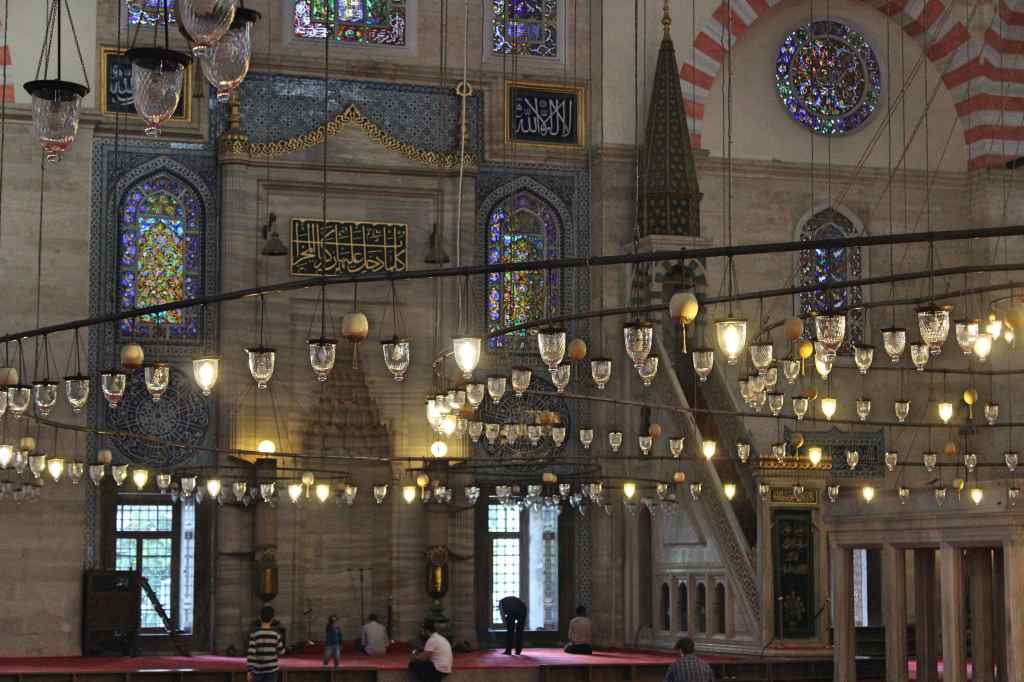
I must mention here a fact that testifies to my own general ignorance. While waiting for Holden, I peaked into a large tomb, which a sign said was for a man named Suleiman. Somehow, I did not realize that this was Suleiman the Magnificent himself, who is buried right outside his eponymous mosque.
Next, we had a Christian monument to visit, the Chora Church. Its name (Greek for “field” or “countryside”) actually refers to the fact that this church originally stood outside the city walls of Constantinople; and even now, the church is far from the city center. Holden and I elected, unwisely, to walk the few kilometers to the church, thinking that we could see some of the city on the way. Instead, we ended up walking through ugly urban wastelands, alongside busy and noisy roads. It was not pleasant. Thankfully, once we got nearby, we popped into a little café for some Turkish coffee. And we were charmed to find posters of Hollywood films in Turkish hanging nearby.

When we got to the church, Holden’s sagacity in purchasing the Istanbul pass was decisively demonstrated, as he was able to walk right inside, while I had to wait for about 20 minutes to buy a ticket (the ticket office being monopolized by a tour guide buying dozens of Istanbul passes). So, once again, if you go to Istanbul get the pass.
The church was undergoing extensive restorations when we visited, so there was almost nothing to see on the outside, as it was entirely covered with scaffolding. But the church is famous for its interior, anyway. This is because of the gorgeous and astoundingly complete set of Byzantine mosaics that cover the ceilings. Though the church was originally built in the 4th century, these decorations hail from the 14th century, a period of artistic splendor known as the Palaeologan Renaissance. Typical of Byzantine art, the mosaics feature somewhat abstract figures against a glittering, golden background. The mosaics are astounding for their quantity as much as their quality—far surpassing those in the Hagia Sophia, even though Chora is so much smaller.

I should note here that, last year, shortly after the decision to reconvert the Hagia Sophia into a mosque, it was announced that the same was to be done with Chora. Like the Hagia Sophia, this church had spent several centuries as a mosque (known as the Kariye Mosque), until it was converted into a museum in 1945. A Turkish court decided that this conversion was unlawful, and that it should be used as a mosque once again. Personally I found this decision rather odd, as it does not seem practical to cover up the dozens and dozens of Christian images, which the Muslim faith demands. But I suppose it is their monument to dispose of.
To return to the city center, we decided that we had better take a bus rather than walk this time. By chance, the main bus hub we found was right next to the iconic Theodosian Walls. This is a set of double walls, built around the ancient city by the order of Theodosius, who reigned in the 5th century. The walls are both tall and thick; and having two layers of protection only made them more formidable. It is worth going out of your way to see them, as the imposing walls of Constantinople are largely responsible for the Byzantine Empire’s longevity, making the city almost impregnable until the advent of cannons. Indeed, over 60 cannons—including one super-sized cannon, weighing over 30 tons—were used by Mehmet II to finally capture Constantinople.

Now, here I must break off this long list of beautiful monuments, in order to introduce you to an experience. I am talking about the Turkish Bath. Normally I don’t go in for this sort of thing. I have never gotten a massage. But Holden was adamant: we absolutely had to get a Turkish bath if we were in Turkey. Here is how it went.
After looking around for a good place, we decided on one that advertised itself as being traditional (I think it was Çemberlitaş Hamamı, near the Column of Constantine). The price was about 30 euros per person, which I found reasonable. Then we were guided to the changing room, or sogukluk, which is a kind of enclosed courtyard with multiple floors. We were led up the stairs to a little room with a glass door; then the attendant handed us two towels and said something like “Take off your clothes and put these on.” (I should note that both the changing room and bathing areas are segregated by gender.)
At this point I panicked. First of all I still have my puritan notions of nudity to contend with, so I did not feel at all comfortable disrobing. But my other problem, as I soon found out, was that I had no idea how to properly fasten a towel around my waist. I confessed this difficulty to Holden—who, for his part, was feeling totally at ease and eager for his massage—who almost passed out from laughter. When he collected himself, he kindly helped me to wrap myself with the garment, explaining the principle to me. (At home and at college, I had always carried my clothes into the bathroom with me to shower, so I never had to learn!)
Then, we were led from the changing room (where we left our things) to the sickaklik, the bathing room. This is quite an impressive space. The room has twelve walls, and sits under a large dome, which is perforated with little, star-shaped holes for ventilation. In the center is a large, raised platform; and all around the periphery are little niches with fountains. We were instructed to lie down on the slab and wait (we had a little towel to cushion our heads). Holden explained that we had to be properly sweaty for the bath. This was no problem, as it must have been nearly 100 degrees inside, the air dense with moisture.
After about 10 minutes of silent sweating, we were approached by two burly Turkish fellows, who explained (in functional English) that they were there to bathe us. The first step of the process is pretty jarring. My gentle masseuse started to vigorously scrub my skin with a kind of rough cloth (called a kese), I suppose with the goal of exfoliation. It was not exactly painful, but it could not be called soothing, either. Then, my attendant filled a bucket with very soapy water, and proceeded to lather my raw epidermis. After properly suddy, I was instructed to get up and go to one of the bathing niches, where I knelt down as he poured hot water over me. As the final step, I was taken outside the bathing room to a kind of adjoining room. Here I was once again instructed to kneel down, as the attendant vigorously scrubbed my hair and scalp with a bar of soap, and then once again doused me with bucketfuls of hot water.
We were back on the street in about an hour. Holden, for his part, felt absolutely clean, refreshed, and rejuvenated. I mainly felt exhausted from the sensory overload; but it is an experience I will certainly never forget, and will perhaps someday repeat.
So Istanbul has much to offer in the way of history, architecture, cruises, haircuts, and baths. But it would be criminal not to dwell on the food. It was delicious, filling, and cheap—a winning combination, if ever there was one. I have already had occasion to laud the kebab. It was consistently good (most distinctively, it was served with pickles), though I have to admit the best kebab I ever tasted was still in Berlin. The sweets were also excellent. Istanbul of little pastry shops, with displays filled to the brim with tiny packets of delight. I ordered a little plate of baklava every chance I got, and the kunefe was also scrumptious. Another joy was the coffee: it was both very strong and very sweet; likewise for the tea. After a few baklavas and a cup of Turkish coffee, I was always ready for more adventure.
Another common sort of shop are buffet-style restaurants, with hot food—vegetable, meat, and fish dishes—behind a pane of glass, for you to choose. Holden and I ate at one of these; and, judging from the other clientele, it was the most “authentic” place we went to. But the real stand-out place was Falafel House. We went there our first night for dinner, and returned every night for the rest of the trip. I ordered the same thing every time: falafel, hummus, and tabouleh (a kind of salad made from parsley, mint, cucumbers, and bulgur wheat). Not only was it vegetarian, but vegan, and (to repeat myself) delicious, filling, and cheap. Unfortunately for Holden, he suffered from food poisoning on our final night, which is strange, considering that we ate almost the exact same things during the trip. But in general I would rank Istanbul very high in gustatory pleasure.
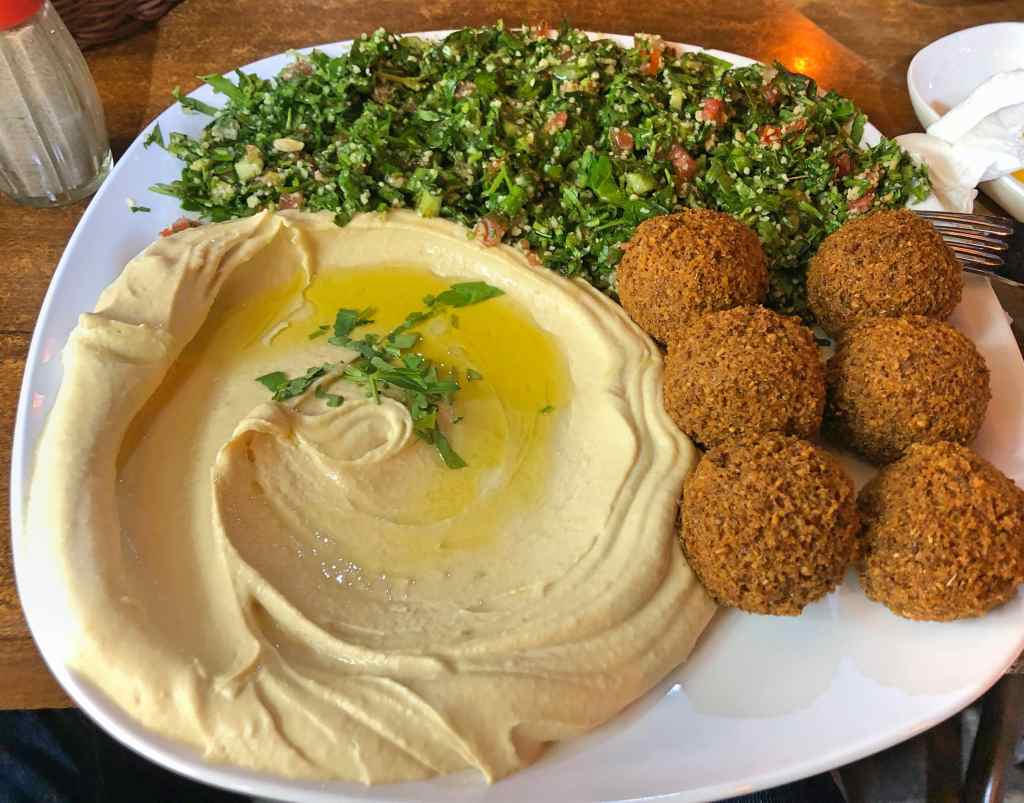
For our last night in the city, we decided to cross the Bosphorus to visit Asia. So we hopped on another ferry and traveled over to Kadıköy. As I stepped off the boat, I felt a strange thrill: this was my first time in Asia—officially, the fourth continent (after North America, Africa, and Europe) that I had stepped foot in. This part of town was quite different from what we had already seen. First we passed through an enormous market, selling fresh vegetables, jars of pickled foods, cheeses, olives, sweets, fish, spices—a garden of earthly delights Then, we found ourselves surrounded by trendy bars. This, alone, was striking, as establishments mainly devoted to alcohol were absent from the Istanbul we had seen. The people looked different, too. Both men and women were dressed as hipsters; and, notably, many were walking their dogs. (Virtually all the dogs we had seen up until then were strays.) Clearly, this part of town was more Westernized.
Holden and I strolled around, eventually coming to a park on the water. There, young people were lounging on the grass, drinking wine; and a group of boys were playing basketball. The Bosphorus gently lapped the rocky shore, as couples held hands and kissed (it also occurred to me that I had not seen any public displays of affection until then). Holden and I decided to have a coffee, where we found that the establishment had backgammon boards available. We played a game (my first) and I narrowly lost. To drown my sorrows, I then had a drink at a bar.
If Holden’s boat theory was not definitely proven during our Bosphorus cruise, it was strongly verified on our return back across the Bosphorus. At night, as the city lights played on the placid waters, with mist sweeping in from the sea, the city took on a dream-like quality. One could easily imagine what it could have been like for a traveler, years ago, to see the towers, mosques, and minarets rise up in the distance over the waves. This was Constantinople.
As I mentioned before, our final night was somewhat marred by Holden’s getting food poisoning. (We also watched the disappointing penultimate episode of Game of Thrones, which didn’t help.) In the airport, the next day, we noticed some men with shaven heads, partly wrapped in towels, with odd red patches on their scalp. This is evidence of Turkey’s increasing medical tourism, specifically for hair transplants, which are apparently far cheaper than in most Western countries. (According to this article, however, the quality is inconsistent and the procedure potentially dangerous.) Finally, we boarded the plane back to Madrid, which was just as comfortable and luxurious as the ride there had been. It was an extraordinary trip.
